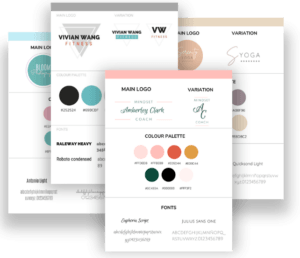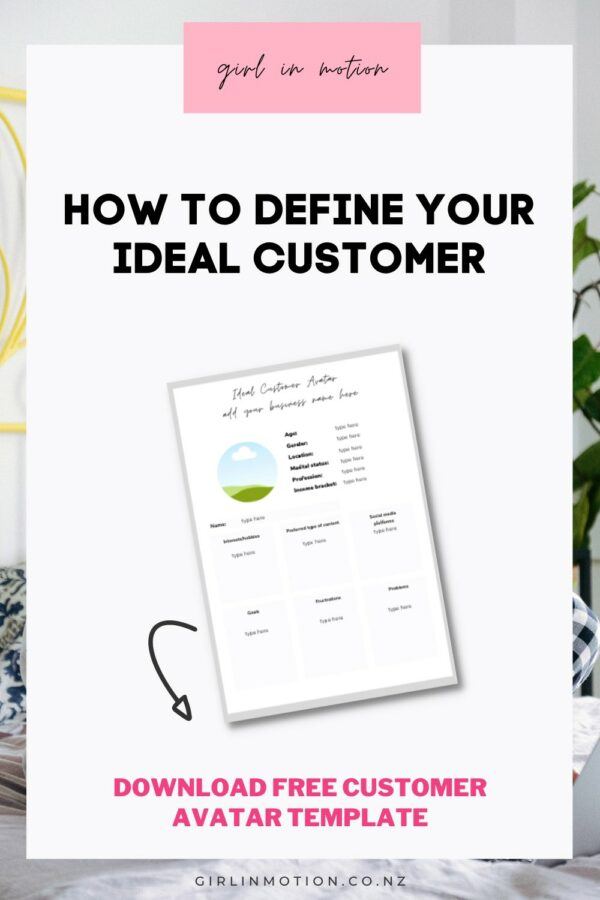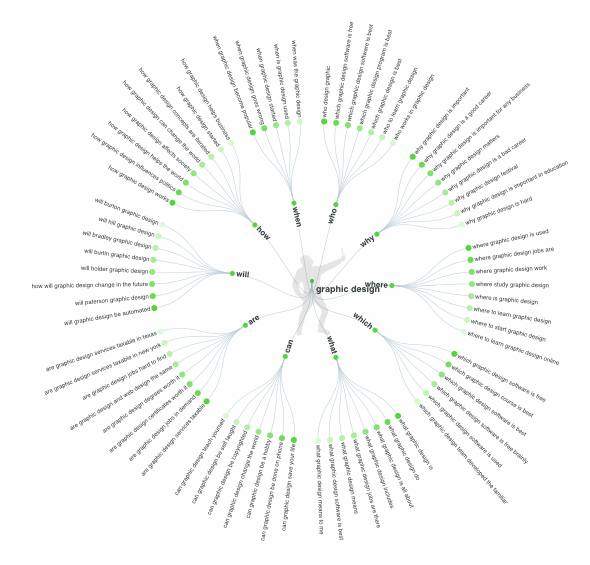
When you are just starting a business, it can be helpful to think of who your ideal customers will be. Why? You may wonder. Well, the answer is pretty simple: creating a picture of your ideal customers will help you to showcase your business in a way that will resonate with them.
Your business doesn’t have to appeal to the masses, but it must be presented in a way that will engage your ideal audience. Knowing your ideal customers will also allow you to tailor your services based on the problems that you can solve for them. How do you this? Read on to find out!

Defining your audience
Every business has a different audience. For example, if you start a real estate copywriting business (like I did!) you will have a different audience from someone that is starting an online store selling scrunchies. This doesn’t mean that my customers don’t wear scrunchies, but it just shows that you would communicate with each of these audiences differently.
Ideal customer Avatar
It is often recommended that businesses create what is called an ideal customer avatar. This is a fictional person (or people) that represents your ideal customer.
It can be very helpful for you to go through this exercise and create an ideal customer avatar for your business. Give it a name and a photo, and you can refer back to him or her as you start creating content for your business.
For example, this is Jess – the ideal customer avatar I have created for this article:
Now that we have given a name and photo to our ideal customer, we can start to really get into her mindset, understand how she feels and how we can help her overcome her problems and frustrations.
How to create your own ideal customer avatar
Here are some initial questions and ideas that you can consider when thinking about your ideal customer:
- Key demographics: How old are they? Where do they live? Are they male or female? Married or single?
- What type of content do they engage with? Blog posts, emails, videos, social media, etc
- What are their interests/hobbies? (Do they like sports, books, cooking) What do they do during the weekend? In the evenings? What are their values?
- Are you more likely to find them on Instagram, Linkedin, Pinterest or somewhere else?
If you can help more than one type of customer, it’s a great idea to have an ideal customer avatar for each of them.
You may also like: 7 awesome benefits of having a business niche
Understanding how your ideal customer thinks
Besides defining your ideal customers’ demographics, it is important to get into their heads to understand how your customers think. Try to really get a sense of what would motivate them to reach out to a business like yours.
Try to put yourself in Jessica’s shoes to understand her pain points, problems, and frustrations. What will make her pick up the phone and give you a call? What’s happening in her business and everyday life that requires your help?
These are some questions that you can consider:
- What are your ideal customer’s challenges/frustrations?
- What motivates them to seek out a business like yours?
- What is their ideal outcome after using your product or service?
- What results do they want?
- What’s holding them back from achieving this goal?
- What problems/needs do they have that your business is solving?
Focus on problems
Even if we are not fully conscious about it, we buy products or services because we have a problem that needs solving or a need to be met. Think about the latest purchases that you’ve made – what was the problem or need behind them?
Maybe you bought a new pair of shoes for the gym or downloaded an app to help you be more mindful.
Now think about the products or services that you want to offer your customers – what is the ultimate problem that it is going to solve?
Thinking back to our fictional ideal customer – Why should Jessica care about your business?

FREE BRANDING BOARDS 🎉
Think about your ideal customer. What problems do they face?
Your customers may not know what is the solution to their problems just yet, but they often know what those problems are. They would normally come across your business while researching for a solution.
When you are creating content for your business, think back to these problems. Your challenge is to communicate your services in a way that they are portrayed as a solution to your ideal customer’s needs.
Think of this question from your customer’s point of view. Imagine Jessica thinking:
“What’s in it for me?”
“How is my life/business going to be easier/better after engaging your services?”
Focus on the benefits that you can offer such as saving time, being healthier, increasing sales, and so on.
How to figure out your customers’ problem
Doing market research is often a good way to get a great insight into your ideal customer’s problems.
This doesn’t need to be anything too formal. If you know anyone that fits within your ideal customer profile, take them out for a coffee and talk through your ideas. Take a pen and paper, ask them some questions, and note down the answers. Give them a call and have a chat over the phone, or send them questions by email.
You can also talk to any past and current customers that you may have, your followers on social media, or any friends, family, or acquaintances that may fit your ideal customer’s profile.
You can also do market research by approaching businesses that you use as a customer. For example, if you want to do food photography, you can go to your local cafe and chat with the owner. Explain what you are planning to do and ask for their thoughts as you buy your latte.
You may also like: How to stop procrastinating and crush your to-do list
What questions to ask
As you are doing your market research, ask people what their struggles and frustrations are, rather than what they need. They may not know what the solutions to their problem are. It is your job to figure that out!
On the other hand, they will be well aware of their frustrations and, with the right questions, they should be able to communicate them to you.
Things to consider
- Ask questions to gather information about their business and the way they operate.
- What are their current frustrations? (especially the ones that relate to problems that you can solve)
- How have they tried to address their pain points?
- Where do they look to find more information about dealing with their problems?
- How satisfied or dissatisfied have they been with what they’ve tried? Why?

Online research
You can also get some ideas on your ideal customer’s problems and paint points by researching online. Here other things you can try:
Competitors: Check out your competitor’s websites. Follow them on social media. What services do they offer? What do they talk about on their feeds? What do they blog about?
Reviews: What do customers in your industry value when they leave a review? What does an outstanding result look like for them? If you find negative reviews, what issues are people highlighting in them?
Industry forums or Facebook groups. What are people talking about? What are the hottest topics?
Answer the Public: this is a cool site that is worth a look. Type in a search term and it will give you a list of questions and related topics based on what people search for using search engines. For example, this is what I get if I type in “Graphic design, New Zealand”

As you can see, this gives you some pretty wonderful insight in the minds of people that are searching for a solution within your industry.
Try typing a few terms relating to your industry and see what comes up! What solutions are people searching for? (you only get a limited number of free searches per day)
Why all of this matters
Once you understand all of the above, you will be in a better position to present your business in a way that will truly resonate with your ideal customer.
This will also help you define your products and services so you can create solutions that serve their specific pain points and problems.
Once you have a clear idea of who your ideal customer is (hello Jess! 👋🏻) and how you can find them, you will be able to share your message in places where they will be found by the right people. Your message can be also crafted in a way that captures their interest and speaks to the specific problems that they have.
So spend some time finding your Jess and trying to understand her problem. It will be worth it >> Download your free Customer Avatar template below.
Want more tips and inspirations? Read these:



Such great tips! I love your template. Just signed up to receive it. Thank you!
Thanks Ana! I am so happy to hear that you like the template.